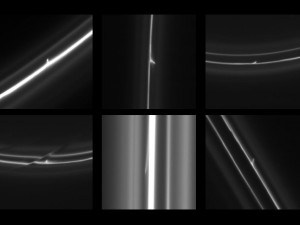Mystery Objects Spotted Piercing Saturn’s Ring - leaving a glittering trail of mini-jets behind -

A NASA space probe studying Saturn recently treated scientists to a bit of a surprise – rather odd little objects piercing in and out the planet’s F Ring, leaving a glittering trail of mini-jets behind.
The objects appear to travel in packs, producing multiple mini-jets which look like the barb of a harpoon.
Scientists already knew somewhat large objects can create channels, ripples and snowballs, or clumps of icy material, within the F ring. What they didn’t know was what happened to these objects after they were created. Scientists thought some of these “snowballs” were broken up into smaller pieces by collisions or tidal forces as they orbited in the F ring around Saturn.
These images, from NASA's Cassini spacecraft, show trails which were dragged out from Saturn's F ring by objects that are about one kilometer in diameter. (Photo: NASA/JPL-Caltech/SSI/QMUL ) (Click image for larger view)
Finding the mystery objects suggests scientists now have proof some of the smaller chunks of those collisions survived and, because they were set into varying orbits, these little objects went on to break through the F ring on their own.
To make their findings, scientists carefully went through about 20,000 images produced during the seven years the Cassini space probe has been at Saturn. So far, about 500 of these weird little objects have been found.
“I think the F ring is Saturn’s weirdest ring, and these latest Cassini results go to show how the F ring is even more dynamic than we ever thought,” said Carl Murray, a Cassini imaging team member.
The F ring, Saturn’s outermost main ring, has a circumference of 881,000 kilometers and is considered the most active ring in the Solar System, since its features tend to change over a period of hours.
Saturn’s rings are mostly made of ice with an average thickness of about 10 meters. The pieces of ice that make up the main rings spread out some 140,000 kilometers from the center of the planet.
The Cassini space probe’s next notable encounter will be a flyby past Saturn’s moon, Enceladus, on May 2.
Read more -
http://blogs.voanews.com/science-world/2012/04/24/mystery-objects-spotted-piercing-saturns-ring/

A NASA space probe studying Saturn recently treated scientists to a bit of a surprise – rather odd little objects piercing in and out the planet’s F Ring, leaving a glittering trail of mini-jets behind.
The objects appear to travel in packs, producing multiple mini-jets which look like the barb of a harpoon.
Scientists already knew somewhat large objects can create channels, ripples and snowballs, or clumps of icy material, within the F ring. What they didn’t know was what happened to these objects after they were created. Scientists thought some of these “snowballs” were broken up into smaller pieces by collisions or tidal forces as they orbited in the F ring around Saturn.
These images, from NASA's Cassini spacecraft, show trails which were dragged out from Saturn's F ring by objects that are about one kilometer in diameter. (Photo: NASA/JPL-Caltech/SSI/QMUL ) (Click image for larger view)
Finding the mystery objects suggests scientists now have proof some of the smaller chunks of those collisions survived and, because they were set into varying orbits, these little objects went on to break through the F ring on their own.
To make their findings, scientists carefully went through about 20,000 images produced during the seven years the Cassini space probe has been at Saturn. So far, about 500 of these weird little objects have been found.
“I think the F ring is Saturn’s weirdest ring, and these latest Cassini results go to show how the F ring is even more dynamic than we ever thought,” said Carl Murray, a Cassini imaging team member.
The F ring, Saturn’s outermost main ring, has a circumference of 881,000 kilometers and is considered the most active ring in the Solar System, since its features tend to change over a period of hours.
Saturn’s rings are mostly made of ice with an average thickness of about 10 meters. The pieces of ice that make up the main rings spread out some 140,000 kilometers from the center of the planet.
The Cassini space probe’s next notable encounter will be a flyby past Saturn’s moon, Enceladus, on May 2.
Read more -
http://blogs.voanews.com/science-world/2012/04/24/mystery-objects-spotted-piercing-saturns-ring/

No comments:
Post a Comment